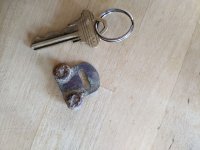The Beep Goes On
Silver Member
- Jan 11, 2006
- 3,403
- 207
- Detector(s) used
- CTX3030, Excalibur II, V3i, TRX
- Primary Interest:
- Metal Detecting
VDI Normalization is the DFX's way of displaying and providing audio based on the familiar 6.67KHz (XLT) VDI number responses. The 3KHz and 15KHz modes generate different VDI responses than we're used to. VDI Normalization changes these responses to the familiar XLT standard.
I read the part in the manual, and in other books, about VDI Normalization, but there wasn't much real world data to work with. In other words, if you turn Normalization off, what do the numbers mean? I hear myself saying "I'm used to the 6.7KHz VDI responses...I'm not going to know what the hell my machine is telling me!". This is the reason I did the bench testing presented here. I wanted to use the Normalization option, but didn't know what to expect. Now, at least, I have some reference data.
We're told that using 3KHz Raw (non-normalized) mode will increase the VDI separation for coins (high conductivity targets) and shrink the VDI separation for gold (low conductivity targets). The 15KHz Raw mode does the opposite, it will shrink the VDI separation for coins and increase the VDI separation for gold. This is why most gold detectors use high frequencies. This is also why a lot of detectors work between 5KHZ and 10KHz...trying to get the best of both worlds.
The benefit of using the Raw (non-normalized) modes is that, with increased VDI separation, you can more easily identify targets and discriminate the junk that may inhabit the same VDI range. If you're hunting coins, use the 3KHz Raw mode. If you're hunting gold, use the 15KHz Raw mode. The increased VDI separation improves your chances of finding desirable targets because you will dig less because you can be more selective. For instance, let's say that you're hunting for gold jewelry and there are two pull-tab varieties infesting the site. If you discriminate the single predominant VDI number of those two types of pull-tabs, causing the Tone ID to cut out on those targets, you will not be discriminating out a lot of the desirable targets. This is because there is a greater VDI separation in the desirable range and it is less likely that, by discriminating the undesirable target, you will miss many desirable targets. If you use the Normalized mode, the desirable and undesirable targets would be more likely to have the same VDI responses.
Below is a table of the targets I bench tested, a chart showing the VDI values and a picture of the targets. It is interesting to note that the three Normalized modes don't always agree. I haven't tried using the Raw modes yet, but with this compilation I have some real world data on which to base my target selection.
HH!
TBGO



I read the part in the manual, and in other books, about VDI Normalization, but there wasn't much real world data to work with. In other words, if you turn Normalization off, what do the numbers mean? I hear myself saying "I'm used to the 6.7KHz VDI responses...I'm not going to know what the hell my machine is telling me!". This is the reason I did the bench testing presented here. I wanted to use the Normalization option, but didn't know what to expect. Now, at least, I have some reference data.
We're told that using 3KHz Raw (non-normalized) mode will increase the VDI separation for coins (high conductivity targets) and shrink the VDI separation for gold (low conductivity targets). The 15KHz Raw mode does the opposite, it will shrink the VDI separation for coins and increase the VDI separation for gold. This is why most gold detectors use high frequencies. This is also why a lot of detectors work between 5KHZ and 10KHz...trying to get the best of both worlds.
The benefit of using the Raw (non-normalized) modes is that, with increased VDI separation, you can more easily identify targets and discriminate the junk that may inhabit the same VDI range. If you're hunting coins, use the 3KHz Raw mode. If you're hunting gold, use the 15KHz Raw mode. The increased VDI separation improves your chances of finding desirable targets because you will dig less because you can be more selective. For instance, let's say that you're hunting for gold jewelry and there are two pull-tab varieties infesting the site. If you discriminate the single predominant VDI number of those two types of pull-tabs, causing the Tone ID to cut out on those targets, you will not be discriminating out a lot of the desirable targets. This is because there is a greater VDI separation in the desirable range and it is less likely that, by discriminating the undesirable target, you will miss many desirable targets. If you use the Normalized mode, the desirable and undesirable targets would be more likely to have the same VDI responses.
Below is a table of the targets I bench tested, a chart showing the VDI values and a picture of the targets. It is interesting to note that the three Normalized modes don't always agree. I haven't tried using the Raw modes yet, but with this compilation I have some real world data on which to base my target selection.
HH!
TBGO



Amazon Forum Fav 👍
Upvote
0









